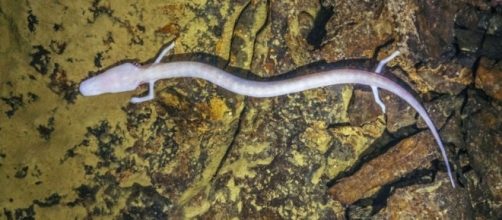A group of divers came across something rather unusual while exploring the depths of a remote Underground Lake in Croatia. At a record-breaking depth of 370 feet (113 meters) the cave divers discovered Olms, scientifically known as Proteus anguinus. The creatures were dubbed "Baby Dragon" amphibians and were seen in a dark limestone cave. This is the deepest any Olms have ever been seen. Scientists expect to find them even deeper, but diving equipment and human limitations prohibit further exploration.
What are Olms?
Olms are very unique creatures.
Elusive and rare, these amphibians have adapted to live in complete darkness at extreme depths. They never see the light of day. Their pinkish-white bodies are long and snake-like, and they can grow up to 1 foot (0.3 meters) in length. Their native homelands are the Balkans and Italy. These small, slender animals are the largest species to dwell in underwater caves of the deep. They are also the only chordates (animal with a spine) to live in these conditions. Their skin has lost all pigmentation due to an adaptation of living underwater at extreme depths. Some people have called them "human fish" because their pinkish-white skin resembles the skin of Caucasian people. However, their most popular nickname is "Baby Dragons." This came out of local folklore and old wives tales.
Sometimes the bodies of these rare creatures will wash up onto the shore. This has sparked the imaginations of many who didn't know what else to call them besides "Baby Dragons." They are blind, but their hearing and sense of smell are quite acute. They have three toes on their front feet, and only two toes on their hind feet.
They breathe via external gills located at the back of their heads. Their mouths are small with tiny teeth that work as a sieve to keep larger objects from going inside. The pinkness of their skin comes from the hue of their oxygen-rich blood.
Conservation Efforts
Not much is known about these rarely seen amphibians. Scientists are working hard to discover more information about these creatures.
They live in a limited area, and conservationists are concerned about whether or not they can be bred in captivity. Fearing for the habitat in which the Olms live, conservationists point to pollution and climate change as the main culprit in the Olms' potentially deadly future. Researchers are attempting to pinpoint where creatures like the elusive Olms live in order to help bring in new regulations to protect their habitats. While these are technically not real baby dragons, they are very important in scientific study and conservation of the planet.


